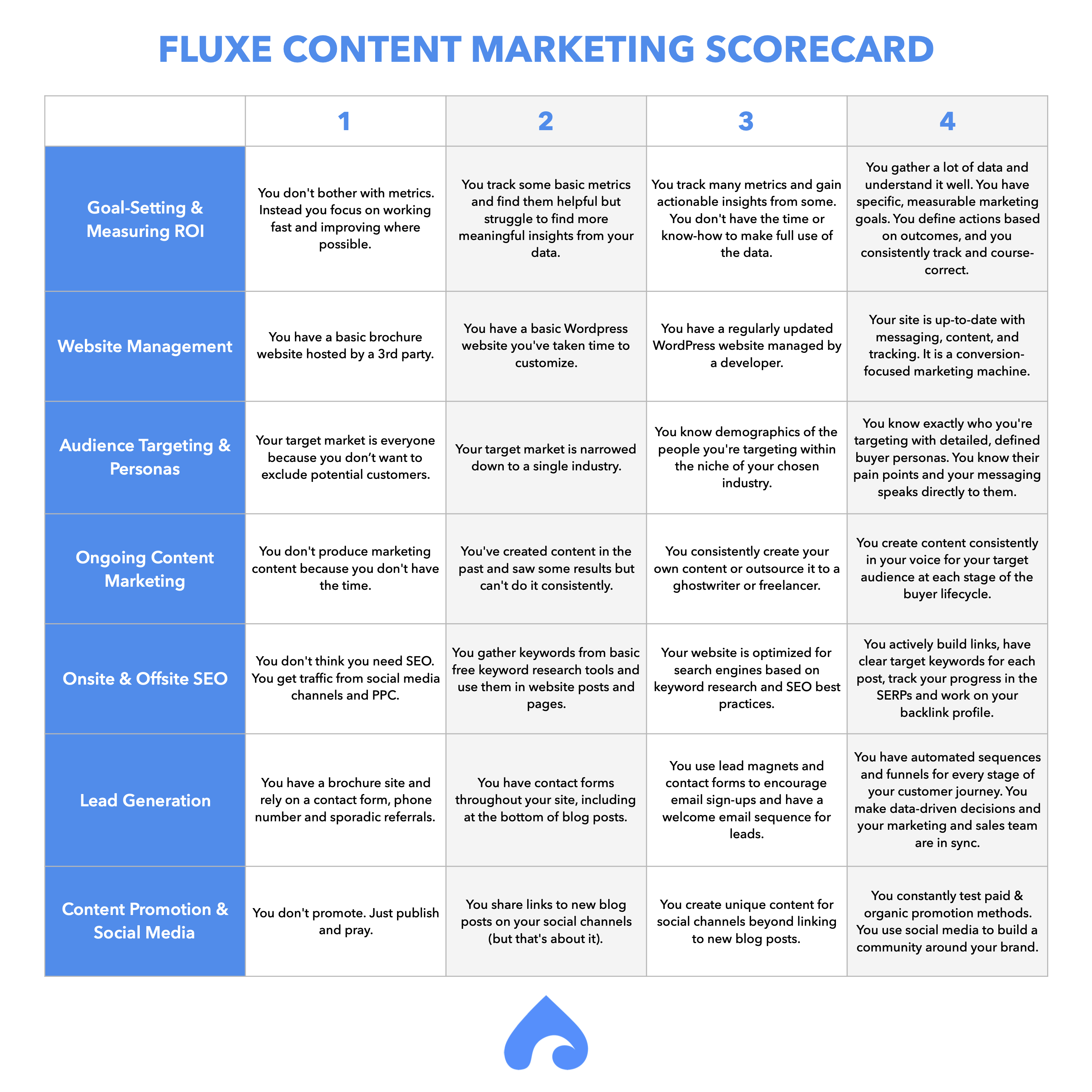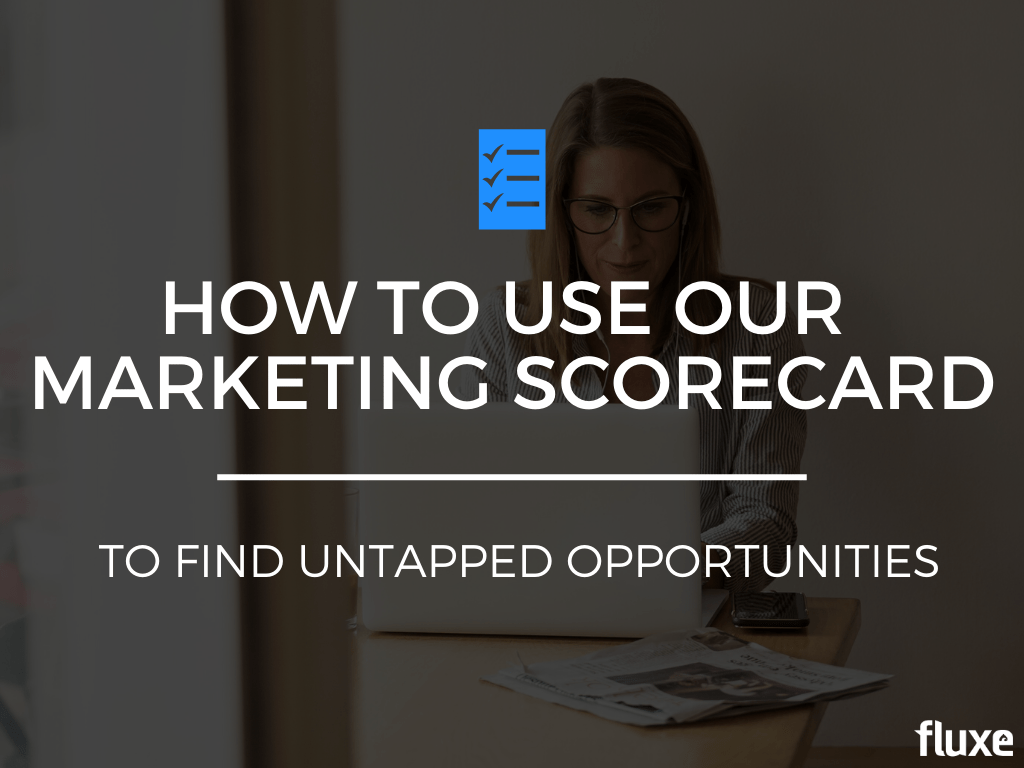Question: How do you actually improve your marketing effectiveness?
First, you need to know where you’re at now.
If you don’t take an honest look at where each part of your marketing is, you can’t create a plan to grow your business.
After helping dozens of talented clients level up their content marketing, one thing stood out.
It’s not that these companies weren’t doing the right things. They just didn’t know what they needed to change to reach the next level.
It’s been such a common theme, we’ve documented each stage to create the Fluxe Content Marketing Scorecard. It shows you what stage you’re currently at, and what to do next.
Basically, it takes out the guesswork.
Nifty, eh?
You can score yourself on each section with a rating of 1-4.
Understanding where you’re at in each area alone can give you clarity and focus. More importantly, the box to the right will show you the next step up for each.
- You have little strategy in place.
- You have basic strategic elements in place.
- You have some best practices and some strategic elements in place.
- You follow all best practices and your marketing strategy is optimized.
Go through the marketing scorecard and give yourself an honest rating of where you are for each area.
You can find a higher resolution version here.
If you need more info on any section, you’ll find a quick explanation on each below.

Goalsetting & Measuring ROI
You already know that if you don’t measure it, you can’t improve it. Content is an investment and tracking data on its performance will help you improve your returns.
- You don’t bother with metrics. Instead you focus on working fast and improving where possible: If you work all hours, it’s easy to think that’s good enough and there’s no need to track results on each marketing task.
- You track some basic metrics and find them helpful, but struggle to find more meaningful insights from your data: Even tracking basic metrics can help you get a feel for how your website and marketing perform. If you know what’s working, you can do more of it and improve results.
- You track many metrics and gain actionable insights from some. You don’t have the time or know-how to make full use of the data: The next step up is analyzing data to find more detailed actionable insights. This helps you refine your strategies and laser focus them to improve marketing ROI further.
- You track a lot of data and understand it well. You have specific, measurable marketing goals and actions based on outcomes you consistently track and course-correct towards: With persistence, data becomes your guiding light, showing you where course corrections are needed for each part of your business. Understanding your data allows you to experiment, providing you with many actionable insights each month.
Website Management
All of your content is either on, or points to, your website. Having your site optimized for conversions helps you get the most from your content.
- You have a basic brochure website hosted by a 3rd party: The easy setups offered by third-party websites are attractive. However, templates often appear generic and many platforms aren’t optimized for SEO or on-page conversions.
- You have a basic WordPress website you’ve taken time to customize: A basic WordPress site offers many customizable features. You can create a unique website that stands out in your niche, ranks well in search and generates more business.
- You have a WordPress website updated regularly and have a developer who manages it: A webmaster can help maintain fast page load speeds and information structure. This boosts SEO and UX to generate more leads and sales.
- Your site is up-to-date with messaging, content, tracking and is a conversion-focused marketing machine: When your website is regularly updated, follows all best practices with content, messaging and tracking, it becomes your best salesperson. It delights your audience and provides you with feedback on what to improve next.
Audience Targeting & Personas
The more specific you are about who your prospects are, the more directly your marketing can speak to them. More sales happen when your messaging is aligned with your audience.
- Your target market is everyone because you don’t want to exclude potential customers: Not wanting to exclude anyone as potential customers is a common trap. But if you were one of your prospects, would you rather work with a jack-of-all-trades or a specialist?
- Your target market is narrowed down to a single industry: When you narrow your audience to a single industry and position yourself as an expert in that sector, you can refine your messaging and your leads become more targeted.
- You know the demographics of the people you’re targeting within the niche of your chosen industry: Most industries have many sub-sectors and niches. If you serve just one and determine your target audience’s demographics within it, you become even more specialized.
- You know exactly who you’re targeting with defined buyer personas. You know their pain points and your messaging speaks directly to them: The final step for targeting is to create a detailed buyer persona. You know precisely who your product or service is for. You know their pain points, their aspirations and objections to buying. All of your messaging speaks directly to them at each stage of the buyer life cycle.
Ongoing Content Marketing
Creating content consistently and to a high standard takes a lot of time and energy. Email, social media and blog content all help grow your audience and build the kind of rapport that generates sales.
- You don’t produce marketing content because you don’t have the time: Prospects now do business with people they feel like they know via blog, email and social media content. But if you don’t have time to spare, you can’t create it.
- You’ve created content in the past and saw some results but can’t do it consistently: If you’ve made content, it probably took longer than expected to create the quality you’re happy with. It’s tough to be consistent, though sporadic content does get some results.
- You publish content consistently or outsource it to a ghostwriter or freelancer: Many people outsource content creation. Even though it’s rarely as high-quality or authentic to their voice as they’d like, at least there’s consistent output and results.
- You create content consistently in your voice and for your target audience at each stage of the buyer life cycle: Consistent content that’s authentic to your voice speaks directly to your target audience and builds relationships. When created for each stage of the buyer life cycle, your audience continually grows, moves down your marketing funnels and converts.
Onsite & Offsite SEO
Organic traffic from search engines can provide long-term dividends from your content. Without it, you leave a lot on the table.
- I don’t need SEO; I get my traffic from social media channels and PPC: It’s common for people to rely on paid advertising from Google, banners or social platforms. It’s a consistent flow of traffic that doesn’t require SEO.
- You gather keywords from basic free keyword research tools and use them in website posts and pages: Since you’re creating a website anyway, even basic keyword research could earn you a little relevant organic traffic and make a few more sales.
- Your website is optimized for search engines, based on keyword research and SEO best practices: If your website is keyword-optimized and follows best practices for SEO, you’re much more likely to earn relevant organic traffic and see more results.
- You actively build links, have clear target keywords for each post, track your progress in the SERPs and work on your backlink profile: Highly targeted keywords, a developed backlink profile and other more advanced SEO strategies are the final step. These help you continually rise in the SERPs, grow your audience, improve awareness and fill your funnels.
Lead Generation
When you set up marketing funnels, you intentionally nudge leads closer to a sale. Without them, your results will be sporadic at best.
- You have a brochure site and rely on a contact form, phone number and sporadic referrals: Depending on how established you or your business is, a basic brochure website and contact form might be enough to maintain your cash flow.
- You have contact forms throughout your site, including at the bottom of blog posts: A contact form at the end of a blog post is a very basic funnel. Your content helps and engages people, encouraging them to sign up for more of the good stuff.
- You use lead magnets to encourage contact form and email sign-ups and have a welcome email sequence for leads: A lead magnet is a valuable downloadable resource. When you upgrade your content with a lead magnet, you encourage more sign-ups, filling those marketing funnels.
- You have automated sequences and funnels for every stage of your customer journey. You’re making data-driven decisions and your marketing and sales team are in sync: Automating your funnel sequences is the next level. When you create multi-stage content for each stage of the buyer life cycle, gathering data on your audience to continually refine the process, you can make sales even while you sleep.
Content Promotion & Social Media
Just because you write it doesn’t mean it’ll be read. Promoting content helps it get seen by the right kinds of people, generating leads and giving you data on how it’s performing.
- You don’t promote. Just publish and pray: When the content is published, spending even more time on it with promotion sometimes isn’t an option. If you don’t have the time or resources to promote it, you just have to hope for the best.
- You share links to new blog posts on your social channels. But that’s about it: The basic level of promotion is to share a link on social media. While it may be better than nothing, this type of promotion is little more than contributing to the noise.
- You create unique content for social channels beyond linking to your new posts: Taking the time to write a unique posts for social media helps engage your audience, connecting them with your brand and your content. This helps you contribute to the conversation rather than the noise.
- You constantly test paid & organic promotion methods. You use social media to build a community around your brand: There are many ways to promote content and testing is required to find the best tactics for your brand and audience. Using UTM tracking links, building relationships within your niche and creating micro content are just a few examples.
Got a question?
If you found this helpful or have any questions, let me know in the comments section below.



